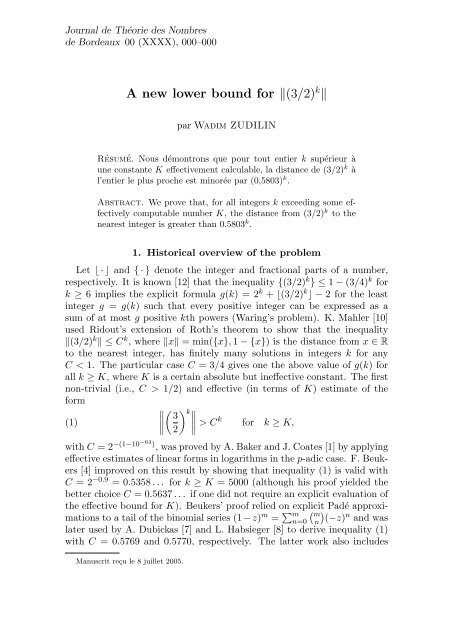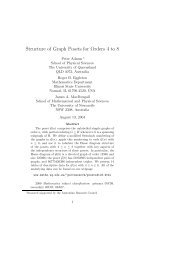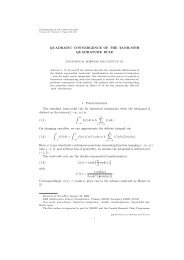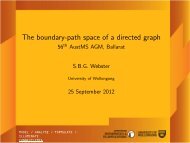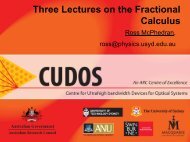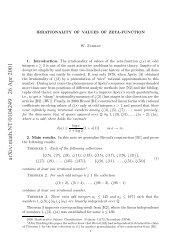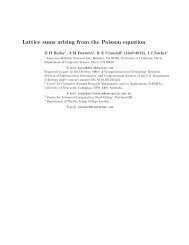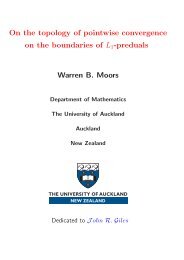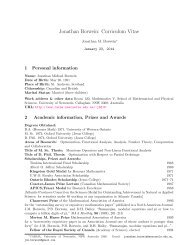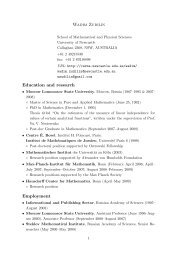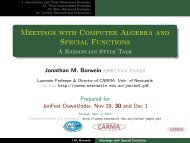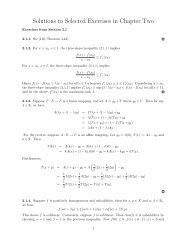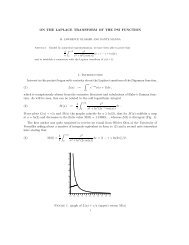A new lower bound for (3/2)k - Wadim Zudilin
A new lower bound for (3/2)k - Wadim Zudilin
A new lower bound for (3/2)k - Wadim Zudilin
Create successful ePaper yourself
Turn your PDF publications into a flip-book with our unique Google optimized e-Paper software.
Journal de Théorie des Nombresde Bordeaux 00 (XXXX), 000–000A <strong>new</strong> <strong>lower</strong> <strong>bound</strong> <strong>for</strong> ‖(3/2) k ‖par <strong>Wadim</strong> ZUDILINRésumé. Nous démontrons que pour tout entier k supérieur àune constante K effectivement calculable, la distance de (3/2) k àl’entier le plus proche est minorée par (0,5803) k .Abstract. We prove that, <strong>for</strong> all integers k exceeding some effectivelycomputable number K, the distance from (3/2) k to thenearest integer is greater than 0.5803 k .1. Historical overview of the problemLet ⌊ · ⌋ and { · } denote the integer and fractional parts of a number,respectively. It is known [12] that the inequality {(3/2) k } ≤ 1 − (3/4) k <strong>for</strong>k ≥ 6 implies the explicit <strong>for</strong>mula g(k) = 2 k + ⌊(3/2) k ⌋ − 2 <strong>for</strong> the leastinteger g = g(k) such that every positive integer can be expressed as asum of at most g positive kth powers (Waring’s problem). K. Mahler [10]used Ridout’s extension of Roth’s theorem to show that the inequality‖(3/2) k ‖ ≤ C k , where ‖x‖ = min({x}, 1 − {x}) is the distance from x ∈ Rto the nearest integer, has finitely many solutions in integers k <strong>for</strong> anyC < 1. The particular case C = 3/4 gives one the above value of g(k) <strong>for</strong>all k ≥ K, where K is a certain absolute but ineffective constant. The firstnon-trivial (i.e., C > 1/2) and effective (in terms of K) estimate of the<strong>for</strong>m(1)∥ 3 k ∥ ∥∥∥∥(> C2) k <strong>for</strong> k ≥ K,with C = 2 −(1−10−64) , was proved by A. Baker and J. Coates [1] by applyingeffective estimates of linear <strong>for</strong>ms in logarithms in the p-adic case. F. Beukers[4] improved on this result by showing that inequality (1) is valid withC = 2 −0.9 = 0.5358 . . . <strong>for</strong> k ≥ K = 5000 (although his proof yielded thebetter choice C = 0.5637 . . . if one did not require an explicit evaluation ofthe effective <strong>bound</strong> <strong>for</strong> K). Beukers’ proof relied on explicit Padé approximationsto a tail of the binomial series (1−z) m = ∑ m( mn=0 n)(−z) n and waslater used by A. Dubickas [7] and L. Habsieger [8] to derive inequality (1)with C = 0.5769 and 0.5770, respectively. The latter work also includesManuscrit reçu le 8 juillet 2005.
2 <strong>Wadim</strong> <strong>Zudilin</strong>the estimate ‖(3/2) k ‖ > 0.57434 k <strong>for</strong> k ≥ 5 using computations from [6]and [9].By modifying Beukers’ construction, namely, considering Padé approximationsto a tail of the series(2)1∞(1 − z) m+1 = ∑n=0( m + nm)z nand studying the explicit p-adic order of the binomial coefficients involved,we are able to proveTheorem 1. The following estimate is valid:∥ 3 k ∥ ∥∥∥∥(> 0.58032) k = 2 −k·0.78512916... <strong>for</strong> k ≥ K,where K is a certain effective constant.2. Hypergeometric backgroundThe binomial series on the left-hand side of (2) is a special case of thegeneralized hypergeometric series( ∣ )A0 , A(3) 1 , . . . , A q ∣∣∣ ∞∑ (A 0 ) k (A 1 ) k · · · (A q ) kq+1F q z =zB 1 , . . . , B k ,qk!(B 1 ) k · · · (B q ) kwhere(A) k =Γ(A + k)Γ(A)=k=0{A(A + 1) · · · (A + k − 1) if k ≥ 1,1 if k = 0,denotes the Pochhammer symbol (or shifted factorial). The series in (3)converges in the disc |z| < 1, and if one of the parameters A 0 , A 1 , . . . , A qis a non-positive integer (i.e., the series terminates) the definition of thehypergeometric series is valid <strong>for</strong> all z ∈ C.In what follows we will often use the q+1 F q -notation. We will requiretwo classical facts from the theory of generalized hypergeometric series:the Pfaff–Saalschütz summation <strong>for</strong>mula()−n, A, B(4) 3F 2 C, 1 + A + B − C − n ∣ 1= (C − A) n(C − B) n(C) n (C − A − B) n(see, e.g., [11], p. 49, (2.3.1.3)) and the Euler–Pochhammer integral <strong>for</strong> theGauss 2 F 1 -series( ) ∫ A, B(5) 2 F 1 C ∣ z Γ(C) 1=t B−1 (1 − t) C−B−1 (1 − zt) −A dt,Γ(B)Γ(C − B) 0provided Re C > Re B > 0 (see, e.g., [11], p. 20, (1.6.6)). Formula (5) isvalid <strong>for</strong> |z| < 1 and also <strong>for</strong> any z ∈ C if A is a non-positive integer.
A <strong>new</strong> <strong>lower</strong> <strong>bound</strong> <strong>for</strong> ‖(3/2) k ‖ 33. Padé approximations of the shifted binomial seriesFix two positive integers a and b satisfying 2a ≤ b. Formula (2) yields(6)( 32) 3(b+1) ( ) 27 b+1 (= = 3 b+1 1 − 1 ) −(b+1)8 9∑∞ ( )( ) b + k 1 k ∑∞= 3 b+1 = 3 b−2a+1b 9k=0k=0∑∞ ( ) b + k= an integer + 3 b−2a+1 3 2(a−k)k=a∑∞ ( a + b + ν≡ 3 b−2a+1 bν=0b)3 −2ν (mod Z).( b + kb)3 2(a−k)This motivates (cf. [4]) constructing Padé approximations to the function∞∑( ) ( ) a + b + ν a + b ∑ ∞(7) F (z) = F (a, b; z) =z ν =bbν=0and applying them with the choice z = 1/9.ν=0(a + b + 1) ν(a + 1) νz νRemark 1. The connection of F (a, b; z) with Beukers’ auxiliary seriesH(ã,˜b; z) from [4] is as follows:∑a−1( ) b + kF (a, b; z) = z((1 −a − z) −b−1 −)z k = H(−a − b − 1, a; z).bk=0Although Beukers considers H(ã,˜b; z) only <strong>for</strong> ã,˜b ∈ N, his constructionremains valid <strong>for</strong> any ã,˜b ∈ C and |z| < 1. However the diagonal Padéapproximations, used in [4] <strong>for</strong> H(z) and used below <strong>for</strong> F (z), are different.Taking an arbitrary integer n satisfying n ≤ b, we follow the generalrecipe of [5], [13]. Consider the polynomial(8)( ) ( )a + b + n −n, a + nQ n (x) =2F 1 a + b a + b + 1 ∣ xn∑( )( )a + n − 1 + µ a + b + n=(−x) µ =µ n − µµ=0n∑q µ x µ ∈ Z[x]µ=0
4 <strong>Wadim</strong> <strong>Zudilin</strong>of degree n. Then(9)Q n (z −1 )F (z) ==n∑q n−µ z µ−n ·µ=0∞∑l=0z l−nn∑µ=0µ≤ln−1∑= r l z l−n +l=0∞∑( ) a + b + νz νbν=0q n−µ( a + b + l − µb)∞∑r l z l−n = P n (z −1 ) + R n (z).l=nHere the polynomial(10)n−1∑P n (x) = r l x n−l ∈ Z[x], where r l =l=0l∑µ=0has degree at most n, while the coefficients of the remainder∞∑R n (z) = r l z l−nl=n( )a + b + l − µq n−µ ,bare of the following <strong>for</strong>m:n∑( )a + b + l − µr l = q n−µbµ=0n∑( )( )( )a + 2n − 1 − µ a + b + n a + b + l − µ= (−1) n−µ n − µµbµ=0= (−1) n (a + b + n)!n∑( ) n (a + 2n − 1 − µ)!(a + b + l − µ)!(−1) µ(a + n − 1)!n!b!µ (a + l − µ)!(a + b + n − µ)!µ=0= (−1) n (a + b + n)!(a + n − 1)!n!b!(a + 2n − 1)!(a + b + l)!n∑ (−n) µ (−a − l) µ (−a − b − n) µ×(a + l)!(a + b + n)! µ!(−a − 2n + 1)µ=0µ (−a − b − l) µ( n (a + 2n − 1)!(a + b + l)! −n, −a − l, −a − b − n= (−1) · 3F 2 (a + n − 1)!(a + l)!n!b! −a − 2n + 1, −a − b − l ∣). 1If we apply (4) with the choice A = −a−l, B = −a−b−n and C = −a−b−l,we obtainn (a + 2n − 1)!(a + b + l)!r l = (−1) ·(a + n − 1)!(a + l)!n!b!(−b) n (n − l) n(−a − b − l) n (a + n) n.
A <strong>new</strong> <strong>lower</strong> <strong>bound</strong> <strong>for</strong> ‖(3/2) k ‖ 5The assumed condition n ≤ b guarantees that the coefficients r l do notvanish identically (otherwise (−b) n = 0). Moreover, (n − l) n = 0 <strong>for</strong> lranging over the set n ≤ l ≤ 2n − 1, there<strong>for</strong>e r l = 0 <strong>for</strong> those l, whileFinally,(11)(a + 2n − 1)!(a + b + l)!r l =(a + n − 1)!(a + l)!n!b!b!/(b − n)! · (l − n)!/(l − 2n)!×(a + b + l)!/(a + b + l − n)! · (a + 2n − 1)!/(a + n − 1)!(a + b + l − n)!(l − n)!= <strong>for</strong> l ≥ 2n.n!(b − n)!(a + l)!(l − 2n)!R n (z) =∞∑∑∞r l z l−n = z n r ν+2n z νl=2n= z n 1n!(b − n)!= z n ( a + b + nb − n∞∑ν=0)ν=0(a + b + n + ν)!(n + ν)!z νν!(a + 2n + ν)!( a + b + n + 1, n + 1· 2F 1 a + 2n + 1 ∣). zUsing the integral (5) <strong>for</strong> the polynomial (8) and remainder (11) we arriveatLemma 1. The following representations are valid:andQ n (z −1 ) =R n (z) =(a + b + n)!(a + n − 1)!n!(b − n)!∫(a + b + n)!1(a + n − 1)!n!(b − n)! zn0∫ 10t a+n−1 (1 − t) b−n (1 − z −1 t) n dtt n (1 − t) a+n−1 (1 − zt) −(a+b+n+1) dt.We will also require linear independence of a pair of neighbouring Padéapproximants, which is the subject ofLemma 2. We have(12) Q n+1 (x)P n (x) − Q n (x)P n+1 (x) = (−1) n ( a + 2n + 1a + n)( a + b + nb − n)x.Proof. Clearly, the left-hand side in (12) is a polynomial; its constant termis 0 since P n (0) = P n+1 (0) = 0 by (10). On the other hand,Q n+1 (z −1 )P n (z −1 ) − Q n (z −1 )P n+1 (z −1 )= Q n+1 (z −1 ) ( Q n (z −1 )F (z) − R n (z) )− Q n (z −1 ) ( Q n+1 (z −1 )F (z) − R n+1 (z) )= Q n (z −1 )R n+1 (z) − Q n+1 (z −1 )R n (z),
6 <strong>Wadim</strong> <strong>Zudilin</strong>and from (8), (11) we conclude that the only negative power of z originateswith the last summand:− Q n+1 (z −1 )R n (z)( )a + 2n + 1= (−1) n z −n−1( 1 + O(z) ) ( ) a + b + n·z n( 1 + O(z) )a + nb − n( )( ) a + 2n + 1 a + b + n 1= (−1) n + O(1) as z → 0. □a + n b − n z4. Arithmetic constituentsWe begin this section by noting that, <strong>for</strong> any prime p > √ N,⌊ ⌋( )N Nord p N! = and ord p N = λ ,ppwhereλ(x) = 1 − {x} − {−x} = 1 + ⌊x⌋ + ⌊−x⌋ ={1 if x ∈ Z,0 if x /∈ Z.For primes p > √ a + b + n, let( {e p = min − − a + n } {+ − a + n + µ } { } µ(13)+µ∈Z pp p{ } { } { })a + b + n a + b + µ n − µ−++ppp(⌊= min − a + n ⌋ ⌊− − a + n + µ ⌋ ⌊ ⌋ µ−µ∈Z pp p⌊ ⌋ ⌊ ⌋ ⌊ ⌋)a + b + n a + b + µ n − µ+−−ppp( )( )≤ min ord a + n a + n + µ a + b + np0≤µ≤n a + n + µ µ n − µ( )( )a + n − 1 + µ a + b + n= min ord p0≤µ≤n µ n − µand(14)( { } { } { }a + n + µ a + n µe ′ p = min −+ +µ∈Z pp p{ } { } { })a + b + n a + b + µ n − µ−++ppp
Set(15)Φ = Φ(a, b, n) =A <strong>new</strong> <strong>lower</strong> <strong>bound</strong> <strong>for</strong> ‖(3/2) k ‖ 7(⌊ ⌋ ⌊ ⌋ ⌊ ⌋a + n + µ a + n µ= min− −µ∈Z pp p⌊ ⌋ ⌊ ⌋ ⌊ ⌋)a + b + n a + b + µ n − µ+−−ppp( )( )a + n + µ a + b + n≤ min ord p.0≤µ≤n µ n − µ∏p> √ a+b+nFrom (8), (10) and (13), (15) we deducep e pand Φ ′ = Φ ′ (a, b, n) =∏p> √ a+b+nLemma 3. The following inclusions are valid:( )( )a + n − 1 + µ a + b + nΦ −1 ·∈ Zµ n − µ<strong>for</strong> µ = 0, 1, . . . , n,henceΦ −1 Q n (x) ∈ Z[x] and Φ −1 P n (x) ∈ Z[x].Supplementary arithmetic in<strong>for</strong>mation <strong>for</strong> the case n replaced by n + 1is given inLemma 4. The following inclusions are valid:(16) ( )( )(n+1)Φ ′ −1 a + n + µ a + b + n + 1·∈ Z <strong>for</strong> µ = 0, 1, . . . , n+1,µ n + 1 − µhence(n + 1)Φ ′ −1 Qn+1 (x) ∈ Z[x] and (n + 1)Φ ′ −1 Pn+1 (x) ∈ Z[x].Proof. Write( )( ) ( )( )a + n + µ a + b + n + 1 a + n + µ a + b + n=µ n + 1 − µµ n − µThere<strong>for</strong>e, if p ∤ n + 1 − µ then(17) ( )( )a + n + µ a + b + n + 1ord pµ n + 1 − µ≥ ord p( a + n + µµp e′ p.· a + b + n + 1n + 1 − µ .)( ) a + b + n≥ e ′n − µp;
8 <strong>Wadim</strong> <strong>Zudilin</strong>otherwise µ ≡ n + 1 (mod p), hence µ/p − (n + 1)/p ∈ Z yielding( )( )a + n + µ a + b + n + 1(18) ord pµ n + 1 − µ{ } { } { }a + n + µ a + n µ= −+ +pp p{ } { } { }a + b + n + 1 a + b + µ n + 1 − µ−++ppp{ } { } { }a + 2n + 1 a + n n + 1= −+ +pp p( ) ( )a + 2n + 1 a + 2n a + 2n + 1= ord p = ord p + ord pn + 1nn + 1( )( )∣ a + n + µ a + b + n ∣∣∣µ=n a + 2n + 1= ord p + ord pµ n − µn + 1≥ e ′ p − ord p (n + 1).Combination of (17) and (18) gives us the required inclusions (16).□5. Proof of Theorem 1The parameters a, b and n will now depend on an increasing parameterm ∈ N in the following way:a = αm, b = βm, n = γm or n = γm + 1,where the choice of the positive integers α, β and γ, satisfying 2α ≤ β andγ < β, is discussed later. Then Lemma 1 and Laplace’s method give us(19)log |R n (z)|C 0 (z) = limm→∞ m= (α + β + γ) log(α + β + γ) − (α + γ) log(α + γ)− γ log γ − (β − γ) log(β − γ) + γ log |z|+ max Re( γ log t + (α + γ) log(1 − t) − (α + β + γ) log(1 − zt) )0≤t≤1and(20)log |Q n (z −1 )|C 1 (z) = limm→∞ m= (α + β + γ) log(α + β + γ) − (α + γ) log(α + γ)− γ log γ − (β − γ) log(β − γ)+ max0≤t≤1 Re( (α + γ) log t + (β − γ) log(1 − t) + γ log(1 − z −1 t) ) .
A <strong>new</strong> <strong>lower</strong> <strong>bound</strong> <strong>for</strong> ‖(3/2) k ‖ 9In addition, from (13)–(15) and the prime number theorem we deduce that(21)log Φ(αm, βm, γm)C 2 = limm→∞ mC 2 ′ log Φ ′ (αm, βm, γm)= limm→∞ m==∫ 10∫ 10ϕ(x) dψ(x),ϕ ′ (x) dψ(x),where ψ(x) is the logarithmic derivative of the gamma function and the1-periodic functions ϕ(x) and ϕ ′ (x) are defined as follows:ϕ(x) = min ̂ϕ(x, y),0≤y
10 <strong>Wadim</strong> <strong>Zudilin</strong>and{−(α + γ)x − y} + {y} − {−(α + γ)x} ={0 if 0 ≤ y ≤ {−(α + γ)x},1 if {−(α + γ)x} < y < 1.The above conditions (23) on ̂ϕ(x, y) imply 1 − {(α + β)x} = {−(α + γ)x}or, equivalently, (β − γ)x ∈ Z.Finally, the sets {x ∈ R : (α + γ)x ∈ Z} and {x ∈ R : (β − γ)x ∈ Z} havemeasure 0, thus proving the required assertion.□Our final aim is estimating the absolute value of ε k from below, where( ) 3 k= M k + ε k , M k ∈ Z, 0 < |ε k | < 1 22 .Write k ≥ 3 in the <strong>for</strong>m k = 3(βm + 1) + j with non-negative integersm and j < 3β. Multiply both sides of (9) by ˜Φ −1 3 b−2a+j+1 , where ˜Φ =Φ(αm, βm, γm) if n = γm and ˜Φ = Φ ′ (αm, βm, γm)/(γm+1) if n = γm+1,and substitute z = 1/9:( ) 3 j (Q n (9)˜Φ −1 2 j · 3 b−2a+1 F a, b; 1 )(24)29( ) 1= P n (9)˜Φ −1 3 b−2a+j+1 + R n˜Φ −1 3 b−2a+j+1 .9From (6), (7) we see that( ) 3 j (3 b−2a+1 F a, b; 1 ) ( ) 3 3(b+1)+j ( ) 3 k≡(mod Z) = ,29 22hence the left-hand side equals Mk ′ + ε k <strong>for</strong> some Mk ′ ∈ Z and we may writeequality (24) in the <strong>for</strong>m( 1(25) Q n (9)˜Φ −1 2 j · ε k = M k ′′ + R n˜Φ9)−1 3 b−2a+j+1 ,whereM k ′′ = P n(9)˜Φ −1 3 b−2a+j+1 − Q n (9)˜Φ −1 2 j M k ′ ∈ Zby Lemmas 3 and 4. Lemma 2 guarantees that, <strong>for</strong> at least one of n = γm orγm+1, we have Mk ′′ ≠ 0; we make the corresponding choice of n. Assumingfurthermore that( ) 1(26) C 0 − C 2 + (β − 2α) log 3 < 0,9from (19) and (21) we obtain)∣ 1 ∣∣∣∣ n( R ˜Φ −1 3 b−2a+j+1 < 1 92<strong>for</strong> all m ≥ N 1 ,
A <strong>new</strong> <strong>lower</strong> <strong>bound</strong> <strong>for</strong> ‖(3/2) k ‖ 11where N 1 > 0 is an effective absolute constant.| ≥ 1 we have|M ′′k|Q n (9)˜Φ −1 2 j | · |ε k | ≥ |M ′′k | − ∣ ∣∣∣R n( 19hence from (19), (20) we conclude that|ε k | >There<strong>for</strong>e, by (25) and)˜Φ −1 3 b−2a+j+1 ∣ ∣∣∣> 1 2 ,˜Φ2 j+1 |Q n (9)| ≥ ˜Φ2 3β |Q n (9)| > e−m(C 1(1/9)−C 2 +δ)<strong>for</strong> any δ > 0 and m > N 2 (δ), provided that C 1 (1/9) − C 2 + δ > 0; hereN 2 (δ) depends effectively on δ. Finally, since k > 3βm, we obtain theestimate(27) |ε k | > e −k(C 1(1/9)−C 2 +δ)/(3β)valid <strong>for</strong> all k ≥ K 0 (δ), where the constant K 0 (δ) may be determined interms of max(N 1 , N 2 (δ)).Taking α = γ = 9 and β = 19 (which is the optimal choice of the integerparameters α, β, γ, at least under the restriction β ≤ 100) we find that( )( )1 1C 0 = 3.28973907 . . . , C 1 = 35.48665992 . . . ,99and⎧1 if {x} ∈ [ 237 , 1 ] [18 ∪ 337 , 1 [10)∪437 , 1 ) [9 ∪ 637 , 1 [6]∪737 , 1 )5⎪⎨∪ [ 837 , 2 ) [9 ∪ 1037 , 5 ] [18 ∪ 1137 , 3 ) [10 ∪ 1237 , 1 ) [3 ∪ 14ϕ(x) =∪ [ 1637 , 4 ) [9 ∪ 1837 , 1 ) [2 ∪ 2037 , 5 ) [9 ∪ 2237 , 3 ) [5 ∪ 2437 , 2 )3∪ [ 2837⎪⎩, 7 ) [9 ∪ 3237 , 8 ) [9 ∪ 3637 , 1) ,0 otherwise,henceC 2 = C ′ 2 = 4.46695926 . . . .Using these computations we verify (26),( ) 1C 0 − C 2 + (β − 2α) log 3 = −0.07860790 . . . ,9and find that with δ = 0.00027320432 . . .e −(C 1(1/9)−C 2 +δ)/(3β) = 0.5803.37 , 718]This result, in view of (27), completes the proof of Theorem 1.□
12 <strong>Wadim</strong> <strong>Zudilin</strong>6. Related resultsThe above construction allows us to prove similar results <strong>for</strong> the sequences‖(4/3) k ‖ and ‖(5/4) k ‖ using the representations( 4 2(b+1) (= 23) b+1 1 + 1 ) −(b+1)(28)8(≡ (−1) a 2 b−3a+1 F a, b; − 1 )(mod Z),8and(29)where 3a ≤ b,( 5 7b+3 (= 2 · 54) b 1 + 3 ) −(2b+1)125(≡ (−1) a 2 · 3 a · 5 b−3a F a, 2b; − 3 )(mod Z),125where 3a ≤ b.Namely, taking a = 5m, b = 15m, n = 6m(+1) in case (28) and a = 3m,b = 9m, n = 7m(+1) in case (29) and repeating the arguments of Section 5,we arrive atTheorem 2. The following estimates are valid:∥ 4 k ∥ ∥∥∥∥(> 0.49143) k = 3 −k·0.64672207... <strong>for</strong> k ≥ K 1 ,∥ 5 k ∥ ∥∥∥∥(> 0.51524) k = 4 −k·0.47839775... <strong>for</strong> k ≥ K 2 ,where K 1 , K 2 are certain effective constants.The general case of the sequence ‖(1 + 1/N) k ‖ <strong>for</strong> an integer N ≥ 5 maybe treated as in [4] and [2] by using the representation( ) N + 1 b+1 (= 1 − 1 ) −(b+1) ( )1≡ F 0, b; (mod Z).NN + 1N + 1The best result in this direction belongs to M. Bennett [2]: ‖(1 + 1/N) k ‖ >3 −k <strong>for</strong> 4 ≤ N ≤ k3 k .Remark 3. As mentioned by the anonymous referee, our result <strong>for</strong> ‖(4/3) k ‖is of special interest. It completes Bennett’s result [3] on the order of theadditive basis {1, N k , (N + 1) k , (N + 2) k , . . . } <strong>for</strong> N = 3 (case N = 2 correspondsto the classical Waring’s problem); to solve this problem one needsthe <strong>bound</strong> ‖(4/3) k ‖ > (4/9) k <strong>for</strong> k ≥ 6. Thus we remain verification of the<strong>bound</strong> in the range 6 ≤ k ≤ K 1 .
A <strong>new</strong> <strong>lower</strong> <strong>bound</strong> <strong>for</strong> ‖(3/2) k ‖ 13We would like to conclude this note by mentioning that a stronger argumentis required to obtain the effective estimate ‖(3/2) k ‖ > (3/4) k and itsrelatives.Acknowledgements. I am very grateful to the anonymous referee <strong>for</strong>his valuable comments (incorporated into the current presentation as Remarks1–3), providing the proof of Lemma 5 and indicating misprints. Myprofound gratitude goes to Anne de Roton, <strong>for</strong> supporting my talk at the24th Journeés Arithmetiques as a muse. I thank kindly J. Sondow <strong>for</strong>several suggestions.References[1] A. Baker, J. Coates, Fractional parts of powers of rationals. Math. Proc. CambridgePhilos. Soc. 77 (1975), 269–279.[2] M. A. Bennett, Fractional parts of powers of rational numbers. Math. Proc. CambridgePhilos. Soc. 114 (1993), 191–201.[3] M. A. Bennett, An ideal Waring problem with restricted summands. Acta Arith. 66 (1994),125–132.[4] F. Beukers, Fractional parts of powers of rationals. Math. Proc. Cambridge Philos. Soc.90 (1981), 13–20.[5] G. V. Chudnovsky, Padé approximations to the generalized hypergeometric functions. I. J.Math. Pures Appl. (9) 58 (1979), 445–476.[6] F. Delmer, J.-M. Deshouillers, The computation of g(k) in Waring’s problem. Math.Comp. 54 (1990), 885–893.[7] A. K. Dubickas, A <strong>lower</strong> <strong>bound</strong> <strong>for</strong> the quantity ‖(3/2) k ‖. Russian Math. Surveys 45 (1990),163–164.[8] L. Habsieger, Explicit <strong>lower</strong> <strong>bound</strong>s <strong>for</strong> ‖(3/2) k ‖. Acta Arith. 106 (2003), 299–309.[9] J. Kubina, M. Wunderlich, Extending Waring’s conjecture up to 471600000. Math. Comp.55 (1990), 815–820.[10] K. Mahler, On the fractional parts of powers of real numbers. Mathematika 4 (1957),122–124.[11] L. J. Slater, Generalized hypergeometric functions. Cambridge University Press, 1966.[12] R. C. Vaughan, The Hardy–Littlewood method. Cambridge Tracts in Mathematics 125,Cambridge University Press, 1997.[13] W. <strong>Zudilin</strong>, Ramanujan-type <strong>for</strong>mulae and irrationality measures of certain multiples of π.Mat. Sb. 196:7 (2005), 51–66.<strong>Wadim</strong> <strong>Zudilin</strong>Department of Mechanics and MathematicsMoscow Lomonosov State UniversityVorobiovy Gory, GSP-2119992 MoscowRussiaURL: http://wain.mi.ras.ru/E-mail : wadim@ips.ras.ru


